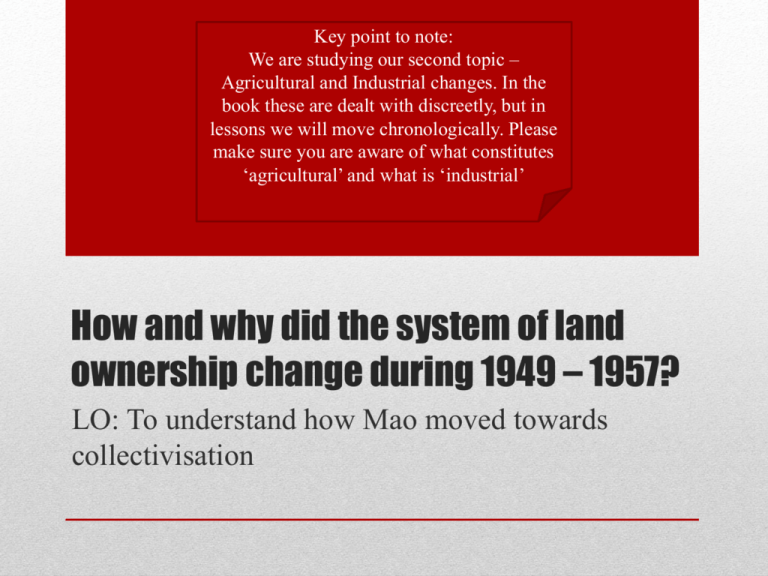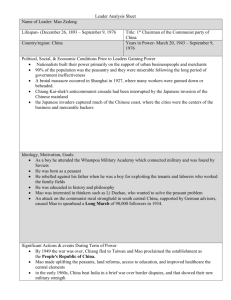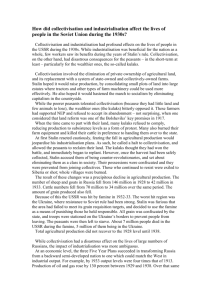15. Land Reform and Collectivisation
advertisement

Key point to note: We are studying our second topic – Agricultural and Industrial changes. In the book these are dealt with discreetly, but in lessons we will move chronologically. Please make sure you are aware of what constitutes ‘agricultural’ and what is ‘industrial’ How and why did the system of land ownership change during 1949 – 1957? LO: To understand how Mao moved towards collectivisation • The process where the state takes over the ownership of land and equipment that was previously in private hands. Collective farms were to be managed by the state, which supplied the peasants with food and accommodation in return for their labour Key term: Collectivisation • Mao always intended on modernising country away from a peasant society through urbanisation and industrialisation (challenge strength of USSR) • Agriculture should be collectivised to feed the industrial workers (and to free up people to move to the cities and work) • Mao put blind faith into will power and mass participation & dismissed the advice of experts • This led to an economic disaster in 1960 Land reform: Mao’s motives for change • Land was distributed from landlords to peasants very quickly, although the change from peasant ownership to collectivisation was very slow. • Starting in ‘key point’ villages, teams of 30 – 40 CCP cadres working with local peasants’ associations fanned out across the countryside to carry the revolution to remote areas. Local peasants were encouraged to identify their landlords, who were then subjected to humiliation and violence. • The CCP involved peasants in this process and deliberately stoked up the class-conflict in order to cement their relationship with the revolution. TASK: Read p.193-195 and complete all the questions in the pink box on p.195 Ext: Ask for the Breslin Stage 1: Land Reform article to add to your notes on land reform (especially for q.5) • What can we learn from source 1 about the way in which land reforms were carried out? Source 1 p. 194 • Read the extract from Breslin about land reform and collectivisation • Make notes on how and why land reform developed into collectivisation & what the results were Homework: Reading How & why did Land Reform develop into collectivisation? LO: to understand the stages of development & learn the reform acts LO: To judge how easy this was for the CCP • How and why did the system of land ownership change? Breslin: Feedback How: • Work groups encouraged peasants to take ownership • ‘Peer classification’ if labelled a landlord you were forced to give up land • MATs = Mutual Aid Teams Party sent to make the peasants cooperate • Sharing officials to try and minimise peasant anger Why: • 1. Increase production feed industrial workers • Increase peasant support • Removal of landlords as a political class this makes Mao move quickly as he didn’t want there to be a situation like in USSR with the Kulaks. • Improve society (Chinese gov. justification) • Development of socialist ideas. According to Breslin: • TASKS: 1) Read p. 195 – 196 & timeline. Annotate your timeline to ensure you understand and can explain the steps to collectivisation 2) How easy was it to collectivise agriculture? Complete task 2 on p.197 Move towards collectivisation: Main stages in Mao’s Collectivisation 1953-56 1951 • First cautious steps • Cooperatives and Mutual Aid Teams • Up to 10 households sharing labour, tools, animals • Wealthy peasants excluded January 1956 • July 1955 – 17m households in APCs • Jan 1956 – 75m in APCs • 63% of the population • Only 3% left as private plots 1952/3 • Second stage • APCs group 30-50 households who by now also share land • Strip farming abandoned; more land able to be cultivated • Private ownership by peasants retained under the ‘land-share’, ‘labourshare’ notion • Large profits still made by wealthy peasants – i.e. not part of Mao’s plan 1955 (as a whole) • Higher APCs introduced of 200300 households • Much larger than a normal, single village • More cadres needed to control them • Profit distribution for wealthy peasants reduced; labour share increased • State pressured wealthy peasants to comply 1953-5 • Confusing and contradictory • Fast pace of change demanded by Mao lead to poor execution of the policy on a local level 1953 • Mao says stop the “rash advance” • But this in turn lead to ‘spontaneous capitalism’ again 1954 • In response Mao called for a stop to the “rash retreat” which lead to peasant anger and resistance • A poor harvest followed which lead to city riots when the government tried to requisition food. Jan 1955 • Stop, Contract, Develop campaign launch by Mao to slow the process • No more APCs for 18 months Summer 1955 • Goes back to rapid collectivisation Early changes in agriculture: • By mid-1950s Mao’s personal prestige was such that he could override the concerns of other party leaders • Ignored concerns over the unpopularity of increasing the pace of reforms in order to realise his own ideological goals. • Some historians have referred to the beginning of a ‘civil war’ within the party that was not ended until the Cultural Revolution. Key points to note about Mao & agriculture: • Using your studies of China as a case study – find evidence of the productivity of collectivisation in order to persuade Mr. Osbourne to take up one this option in Britain. • You must persuade using evidence. Which is more productive? Why? China as a case study.





